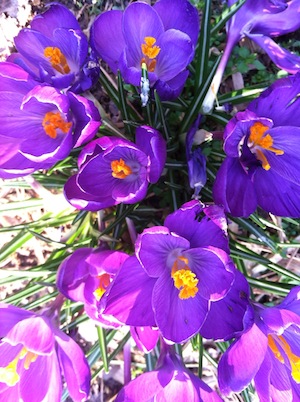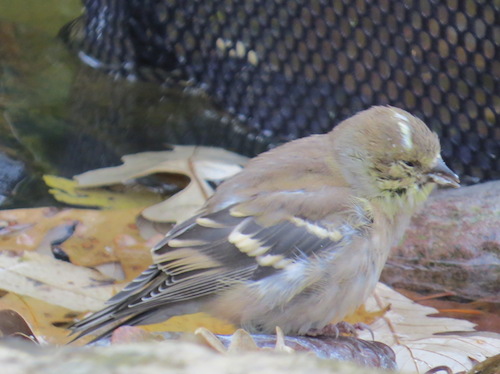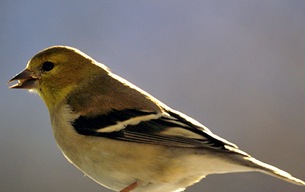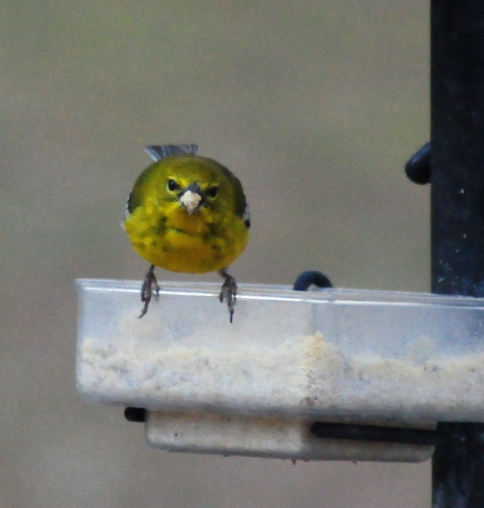-
Finch Bird Feeder Disaster
Without fail buds are blooming and bulbs spring forth from the ground… in February. Likewise without fail, the Atlanta area will experience another cold snap, snow or an ice storm before spring decides she’s here for the duration. The rain’s been fairly continuous for about three weeks, yesterday was a balmy 80 degrees!
Warm, wet weather spells disaster for bird feeders, especially finch bird feeders. It’s not that humidity affects thistle seed any differently from other seed mixes- it’s the unnatural and exaggerated number of birds feeding from the finch feeders.
Local populations of goldfinches, pine siskins and house finches are huge around this time of year. Combined with wet or moldy seed means disease can be spread rapidly, with the feeder itself or ground waste below as the main culprit.
Mold creates airborne disease which is usually fatal to birds. A form of strep, the most common way it’s passed is via the feeder. Telltale signs of infected birds are swollen eyes, lethargy (they allow you to get very close) and ruffled or unkept feathers.
The infected finch below will likely fall prey to predators or starve to death as total blindness sets in. It’s the best excuse for keeping bird feeders clean and the area below them raked free of hulls or waste. We attract birds to our gardens simply because we enjoy their beauty, song and grace… sick birds are anything but 🙁
It’s advised to take all bird feeders down and disinfect with a 10% bleach solution. Clean the ground below feeders well. Wait 2 to 3 weeks until the local thistle-eating population has subsided before hanging feeders again. This is a tough chore, both physically (and mentally for some of us bird nuts). So it’s best to avoid and practice good hygiene when enticing birds to your place! Humans do feathered friends no favors at all by causing disease or allowing it to spread.
-
Got Your Nyjer Feeder Ready?
Goldfinches are back in droves.. but they’re not quite so gold yet. Still sporting drab winter plumage, it’s not until late spring/early summer when they’ll molt again. It’s the process of shedding old worn feathers to make way for new ones, and goldfinches happen to be one of very few birds who molt twice per year.
If your nyjer feeder has been sitting for a while sans activity, the older seed may be moldy, and finches won’t eat it. Consider trashing that old seed, giving the feeder a good cleaning and refilling with fresh goods. Doing this provides a welcome sign for these cool little birds.
One of the larger capacity feeders is shown here – holding 5+ lbs. of seed. A relative of the Rainbow Finch Feeder, the Super version is even better for large finch crowds. With colorful perches and a great design, this nyjer feeder lets you fill from both the top and bottom. This eliminates stale seed piling up at the bottom. By alternating which end is filled with fresh seed, there’s never a build-up of old stuff.
There’s another bird out there now who might easily be confused with the goldfinch. About the same size, but very opposite behavior, warblers can be pretty territorial around bird feeders. Males will fight and fend off others, doing this sort of vertical flight dance where the birds look almost intertwined. Goldfinches on the other hand would rather find another feeder than fight.
This is when an extra thistle sock or two come in very handy. Inexpensive and simple to use, they offer extra feeding spots during goldfinches’ busy breeding season. Oh and this warbler… he’s got a mouthful of suet and a big attitude too!
To roll out the welcome mat for finches and other songbirds, offer a consistent fresh water source and keep bird feeders clean. Adding some nesting materials in early spring will also encourage residency at your place!

 Without fail buds are blooming and bulbs spring forth from the ground… in February. Likewise without fail, the Atlanta area will experience another cold snap, snow or an ice storm before spring decides she’s here for the duration. The rain’s been fairly continuous for about three weeks, yesterday was a balmy 80 degrees!
Without fail buds are blooming and bulbs spring forth from the ground… in February. Likewise without fail, the Atlanta area will experience another cold snap, snow or an ice storm before spring decides she’s here for the duration. The rain’s been fairly continuous for about three weeks, yesterday was a balmy 80 degrees!




